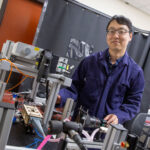
Advanced packaging the next big thing in semiconductors — and no, we’re not talking about boxes
ASU plugged into this next breakthrough in microchip tech with curriculum, partnerships with industry leaders.
Read MoreASU plugged into this next breakthrough in microchip tech with curriculum, partnerships with industry leaders.
Read MoreASU recruits nationwide changemakers in a co-led National Science Foundation initiative to make STEM education more inclusive.
Read MoreOne of ASU’s newest buildings, the Rob and Melani Walton Center for Planetary Health, has a shell made of glass-fiber reinforced concrete panels designed with input from Professor Barzin Mobasher.
Read MoreDhruv Bhate recently talked about ASU’s new Advanced Manufacturing Science and Technology Center and the future of manufacturing.
Read MoreAs one of the largest producers of engineers in the nation, ASU is poised to help develop the talent pipeline needed to meet the demands of the current manufacturing boom.
Read MoreHow does the university R&D advance semiconductor technology and how can we fuel its impact?
Read MoreMikhail Chester and Brad Allenby addressed the urgency of modernizing our infrastructure to meet future needs in a Devils in the Details video.
Read MoreAn Arizona State University undergraduate research project to add smell to virtual reality will help make occupational training more immersive.
Read MoreFor decades, ASU’s Aditi Chattopadhyay has endeavored to create responsive, durable materials.
Read MoreRobots and artificial intelligence are growing more and more autonomous. But they still need to work smoothly with humans to be effective.
Read MoreKonrad Rykaczewski and faculty from ASU’s Biomimicry Center investigated how the...
Read MoreDuring National Cybersecurity Awareness Month, ASU’s Paulo Shakarian shares how he and other researchers are using cybercriminals’ weaknesses against them
Read More